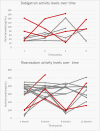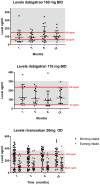The daily practice of direct oral anticoagulant use in patients with atrial fibrillation; an observational cohort study
- PMID: 31170727
- PMCID: PMC6554016
- DOI: 10.1371/journal.pone.0217302
The daily practice of direct oral anticoagulant use in patients with atrial fibrillation; an observational cohort study
Abstract
Background: Direct oral anticoagulants (DOACs) are administered in fixed doses without monitoring. There is still little published data on the impact of the absence of monitoring on adherence to medication and stability of DOAC plasma levels over time.
Objectives: To explore adherence and stability of DOAC plasma levels over time in patients with atrial fibrillation (NVAF) recently started on DOAC therapy.
Patients and methods: A prospective observational cohort study with structured follow up including assessment of adherence to medication, plasma levels at baseline, 3,6 and 12 months and adverse events.
Results: We included 164 patients; 89% were previous users of a vitamin K antagonist (VKA). One-year adherence was reasonably good: Morisky adherence measurement scores of 6-8 in 92%. The majority of DOAC plasma levels were within reported on-therapy ranges; dabigatran (median 104.4 ng/ml, IQR 110.2), rivaroxaban (median 185.2 ng/ml, IQR 216.1) and on average levels were not different for full and adjusted doses. There was significant variation between patients, but no significant differences over time within individuals. A substantial proportion of patients starting in the upper-or lower 20th percentiles remained there during the entire follow up. Seventeen bleedings (16 minor, 1 major) were reported, no ischemic events and bleeding or thrombotic events were not associated with DOAC plasma levels.
Conclusions: Adherence was reasonably good in the majority of patients. Our data confirm the stability of DOAC plasma levels over time. Knowledge of such data may, in the individual patient, contribute to optimal drug and dose selection.
Conflict of interest statement
During the period the work was done, HTC was a consultant to the diagnostic company STAGO. However, for this specific article, this consultancy was essentially not relevant.
Figures



References
Publication types
MeSH terms
Substances
LinkOut - more resources
Full Text Sources
Medical

